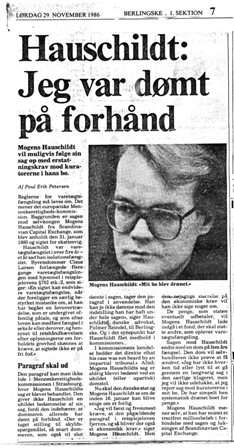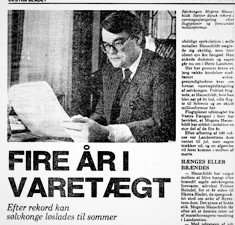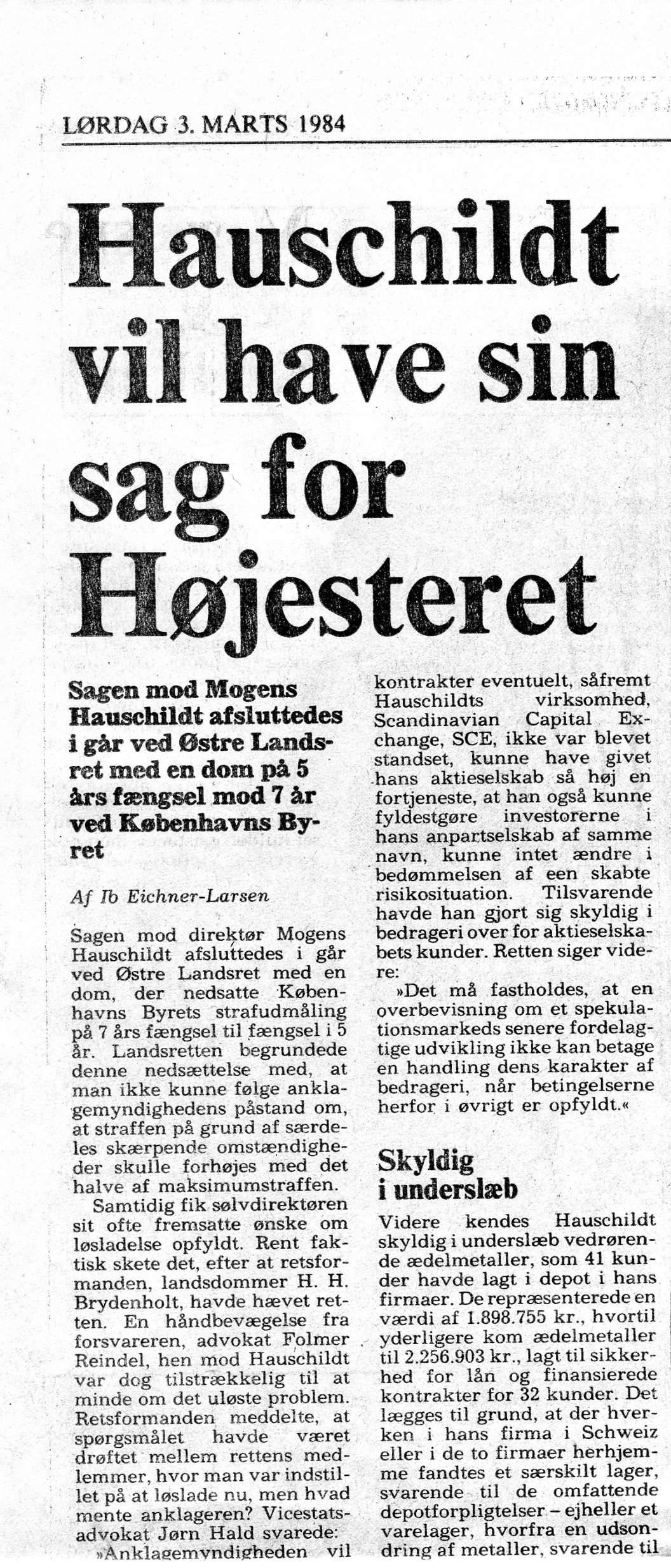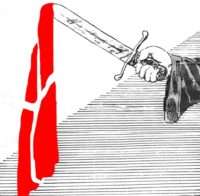Just a Rubberstamp – No Re-trial
Professor Hans Gammeltoft- Hansen (later the Danish Parliamentary Ombudsman for more than 25 years) advised my defence and clearly told them that when I had asked for a re-trial I was entitled to have “A new trial”. This was very important for my defence and me. Moreover in my decision to appeal to the High Court.
If I had known then that the High Court would totally ignore Professor Gammeltoft-Hansen’s legal opinion and the law, I certainly would not have appealed since I could have walked out more than a year before my pre-trial detention ended. I made my appeal on the 15th November 1982 (Ankemeddelelse – 15 november 1982)
After Folmer Reindel told me about Professor Gammeltoft-Hansen views I looked forward to a new trial with having new witness statements and not using the manufactured statement by Judge Claus Larsen from the City Court. I wrote to my defence in January 1983 setting out various points (Notat to Forsvarer 25 January 1983)
It never turned out this way and to the so-called “re-trial” in the High Court and how the witnesses were heard:
“The Danish National Bank, the Ministry of Trade, the Company Register and Copenhagen tax authorities all conspired against Hauschildt and the companies whilst using the involvement of the Ministry of Justice, the Special Prosecution and court as henchmen”
– Advocate Folmer Reindel to the City Court
Normally a witness is a little nervous when entering a courtroom where the press may be present and all the attention is focused on the witness.
It was therefore of some comfort to the witnesses to be greeted by the Special Prosecutor’s assistant prior to entering the courtroom and to be handed a copy of a statement that contained the witnesses’ testimony of several years before.
It was never pointed out to the witnesses that the statements of what he supposedly had said in the City Court were not a true verbatim recording but the work of Judge Claus Larsen’s imagination and recollection; statements/ transcripts which the defence and I had objected to so many times and had wanted to be changed.
The case at the High Court was conducted in a very small courtroom and the witness sat only a few meters away from the six judges. Therefore after hearing many pages read out from a statement to the City Court, it was hardly likely that the witness would object to this statement’s correctness.
In the event of a witness objecting or making any major suggestions for correcting this statement, the judges would question his integrity or truthfulness – the possibility of which could not be ignored. The prosecutor would automatically attack any witnesses who questioned the statement read out, which did happen a few times.
When a witness was asked whether he would stand by his/her statement from the City Court or not, he/she would verify this as a matter of course. Thus, although the witness did have access to correcting his statement, such access was, in reality, only theoretical under the very special circumstances that prevailed.
After a witness had verified the statement from the City Court it became impossible for my defence lawyers to refer to any other understanding of what was actually said in the City Court or to get the witness to change any such statement. If my lawyers questioned the witness too much on this point, the witness became uncooperative.
The Authorities’ Vested Interest in My Case and Guilty Judgement
The fact that the Danish Authorities wanted to cover up all of their actions against me, the companies and the clients of the companies was clear and somewhat understandable from their position.
 The Authorities spent millions in their pursuit to cover up the truth – millions from the Danish taxpayers.
The Authorities spent millions in their pursuit to cover up the truth – millions from the Danish taxpayers.
Despite this, some facts came “out” from time to time; it was difficult to completely cover up everything despite that the Internet did not even exist then. The internal memorandum from the National bank and Copenhagen Tax authorities came to light during the trial and it clearly showed the aim and intended actions by the authorities against the companies and indirectly against me.
An interesting point was made when the liquidators (the vultures) of the companies and my estate told the High Court that the Customs and Excise (Toldvæsenet) should, according to the agreement with my companies, refund the purchase tax (Moms) to the estate. This sales tax had already been paid by the companies on goods that had not been delivered due to the action taken by the Danish authorities.
The interesting point, which clearly showed the authorities interest in having me convicted, was that Customs and Excise would only refund the millions of Kroner paid by the companies if I was not convicted for fraud. In other words, the authorities had a substantial interest in getting a conviction for fraud. Even this most important statement made in the Court was not recorded in the transcript of the High Court.
A New Interpretation of the Law
Until my case, it had been the practice of the courts to interpret the Danish Code of Criminal Procedure (Retsplejeloven) in such a way that it was only the judiciary judges who considered the question as to an accused should remain in incarceration during pre-trial (on remand). This was also the practice with my incarceration during the more than three years in which I was incarcerated; Judge Claus Larsen in the Lower Court never permitted the two lay-judges to take part in this decision.
On the first day of the proceedings at the High Court, Judge Brink had already told the Court that his interpretation of the law was one all members of the court should consider if I should remain incarcerated in pre-trial custody. Since this must have either meant that Judge Claus Larsen at the lower court had been wrong for nearly three years – when every four weeks he “rubberstamped” the Special Prosecutions wish to keep me locked-up – or Judge Brink may have been wrong in his rather special interpretation of something which ought to be quiet clear for the courts.
Professor Hans Gammeltoft-Hansen, told my defence that Judge Brink was wrong in his decision – but never mind a respected law professor’s opinion, even a law professor who later became the ombudsman for Parliament for 25 years.
Considering that this new historic procedure was used regularly every four weeks where the three lay-judges at the High Court also showed their views – and indeed judgement – as to me being kept in restrictive pre-trial incarceration. These lay-judges indirectly gave an indication as to their views and inclinations with regards to any final judgment since they (at least two of the lay-judges), permitted and agreed to my continued incarceration during the trial – this must have been prejudicial since they became committed.
This monthly decision committed the individual members of the court and interfered with a fair trial. That such argumentation was valid can be illustrated from the headlines of the newspapers.
On the 26th August 1983, the BT wrote the headline “For the 55th time! No, you do not get permission to get out, Hauschildt!”
In the article, it concluded that the decision by the High Court to keep me incarcerated reflected that the judges had already (on the first day of the proceedings), given an indication with regards to their final judgment. As to the final judgment, the newspaper stated that I would get at least a sentence of seven years and possibly more since the Special Prosecution was asking for a twelve-year sentence.

For the 55th time Hauschildt we will not set you free
The other controversial decision made by Judge Brink was to permit witnesses to read their “alleged statements” from the Lower Court prior to them testifying to the High Court. In addition to this, the Special Prosecution started the examination with the reading of these alleged statements (the transcript from the lower court).
This transcript was, as previously mentioned, a fabrication by Judge Claus Larsen and did in no way reflect what really took place during the trial. Despite that this transcript did not reflect the truth; such a statement nevertheless became the truth since only a very few witnesses at the High Court would start their testimony with a denial of something written down two years earlier.
Professor Hans Gammeltoft-Hansen, told my defence lawyer, Folmer Reindel that this procedure by the High Court was not in accordance with the law since my defence and I had asked for a completely new trial at the High Court as well as that the witnesses should be questioned again.
It is my contention that these procedural irregularities violated my rights to a fair trial at the High Court and Judge Brink showed bias towards the Special Prosecution (Bagmandspolitiet). One may ask the question why? Why did the High Court make such different interpretations of the law and indeed make such a historic decision in this case?
A Lay-Judge Visual Protest
After a court hearing in mid-October 1983, one of the lay-judges came up to my defence, Folmer Reindel, and I. This lay-judge said, to our surprise, “I have had enough of this injustice and will go right away to my member of parliament to ask for his help”. Although such an action and the statement must be considered highly irregular from a member of the panel of judges in the case, it was very positive for me and Folmer Reindel to witness at the time because it showed that the Danish authorities had some difficulty in covering up the truth. In fact, today I would like this lay-judge to step forward and contact me.
Advocate Folmer Reindel told the European Court of Human Rights in Strasbourg – 26th September 1988:
“It is clear that the Danish authorities had, for a long time, the objective to close down Hauschildt’s successful and profitable business, irrespective that the companies acted correctly and within the Danish law.
From the first day of the action against Hauschildt and his companies, it has been the objective of the Danish authorities to justify their illegal acts at any cost, including keeping Hauschildt in solitary confinement and pre-trial detention for more than four years as a hostage to justice.
The Danish authorities acted within total contempt for the Danish law and justice and the European Human Rights Convention.
Hauschildt become a victim of the Danish state”
As to their rubberstamping Judge Claus Larsen’s verdict, the High Court had little choice. First, they had to throw out two of the ridiculous charges which the lay-judges would not go along with.
Secondly, they somehow had an obligation to discharge the Danish authorities which had kept me locked up in restrictive pre-trial confinement for more than four years.
This allowed the judges to give me an eight-year sentence, as I had served that and would immediately be released anyway. Further, the Special Prosecution had argued for 12 years prison sentence.
As the newspaper headlines say “Bagmandspolitiet wanted to give me a sentence of 12 years prison”. In the end, it became just an issue to justify my more than 4 years of incarceration in pre-trial detention.
The fact that the judges agreed on five years must show that there were some problems with the lay-judges; the jurist judges could not really get their way of serving their masters.
Anyone who knows how the courts worked in Denmark at the time would have known that there must have been a compromise among the judges as well as pressure on the three lay-judges since the final judgment was a “lesser” justification than they could have made.

What Impartiality?
Over the years the decisions by Judge Claus Larsen in the lower court and the juridical judges in the High Court/Court of Appeal greatly influenced their later decisions, they had already committed themselves.
Furthermore, the same judges had to consider their own previous decisions as well as the justification of these decisions years afterwards. For example, the presiding judge in the High Court/Appeal Court, Judge H. H. Brydensholt, who pronounced the final judgment in March 1984, had already (nearly three years before in July 1981) confirmed that I should remain in solitary confinement, a pre-trial punishment and that the Special Prosecution had a strong case against me.
Judge Brydensholt was taking part in the defence appeal decision from the lower court. Because he also had been the head of the prison service he knew what solitary confinement did to people, moreover that any pre-trial detention always had to be justified to the Ministry when sentencing.
The juridical judges taking part in the High Court/Court of Appeal proceedings made ten decisions on keeping me incarcerated prior to the trial during 1981 and 1983. After the commencement of the trial in the High Court, these judges made eight decisions along with the three lay judges on keeping me locked-up together. These decisions did indicate prejudice which was very clear to the Danish media. By incarcerating me and since I had already served a sentence longer than the judgments from the lower court (see newspaper article), the judges clearly showed that the High Court/ Court of Appeal found me guilty at the time.
In 2004 advocate Niels Forsby, who was the chairman of the Association of Danish Defence Lawyers, stated:
“That the long pre-trial incarceration of prisoners in Denmark always seemed to be justified by the courts in their final judgements, in order to save the state from paying any compensation”.
All of my defence attorneys and I knew this back in 1980 (twenty-four years earlier) because that is the true reality as to how the courts and judges acted. In fact, advocate Jørgen Jacobsen pointed this out to the lower court (Judge Claus Larsen) back in December 1980 when he tried to free me on bail after eleven months of pre-trial solitary confinement and punishment.
This at a time that I had not even been charged, but Jørgen Jacobsen knew well that Bagmandspolitiet and the courts would justify anything they did to me, never mind if I had committed any offences. Everything would be justified as he already told me after six months in solitary confinement.




